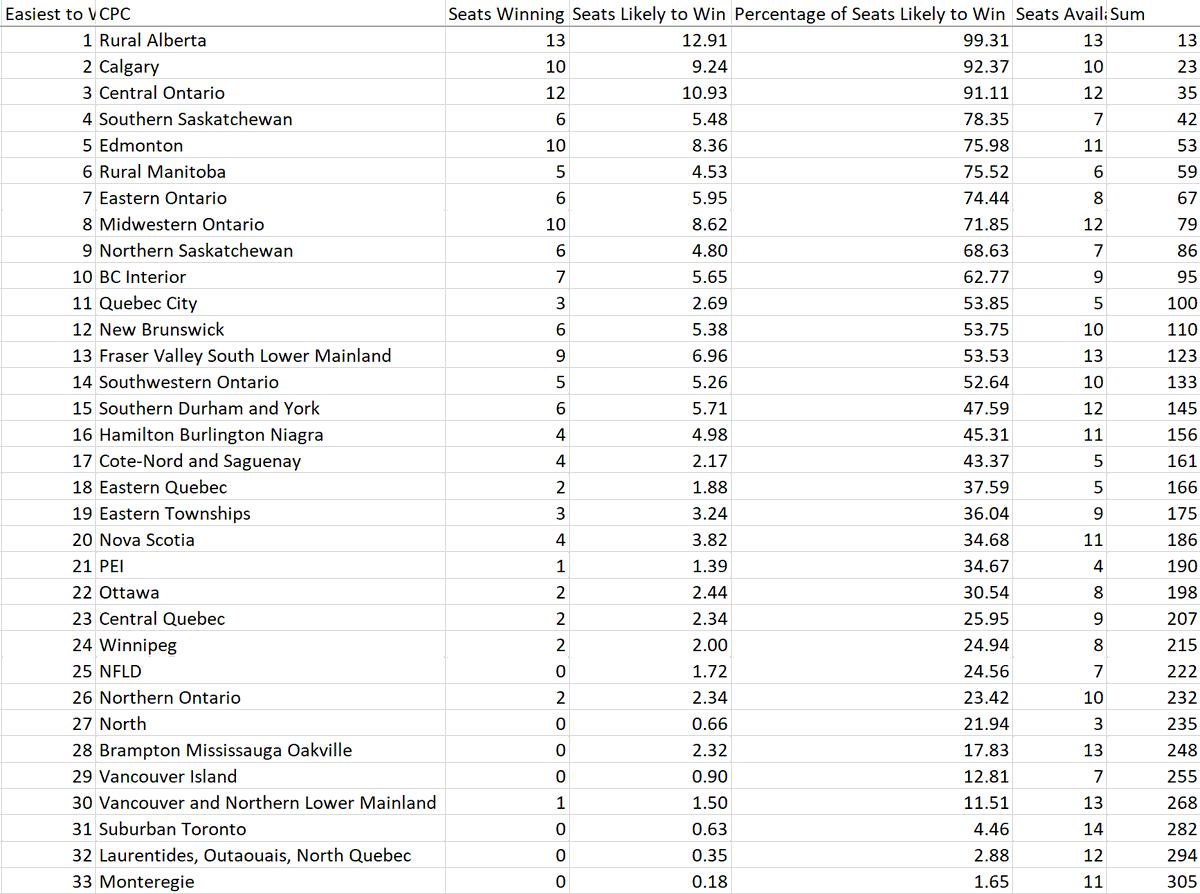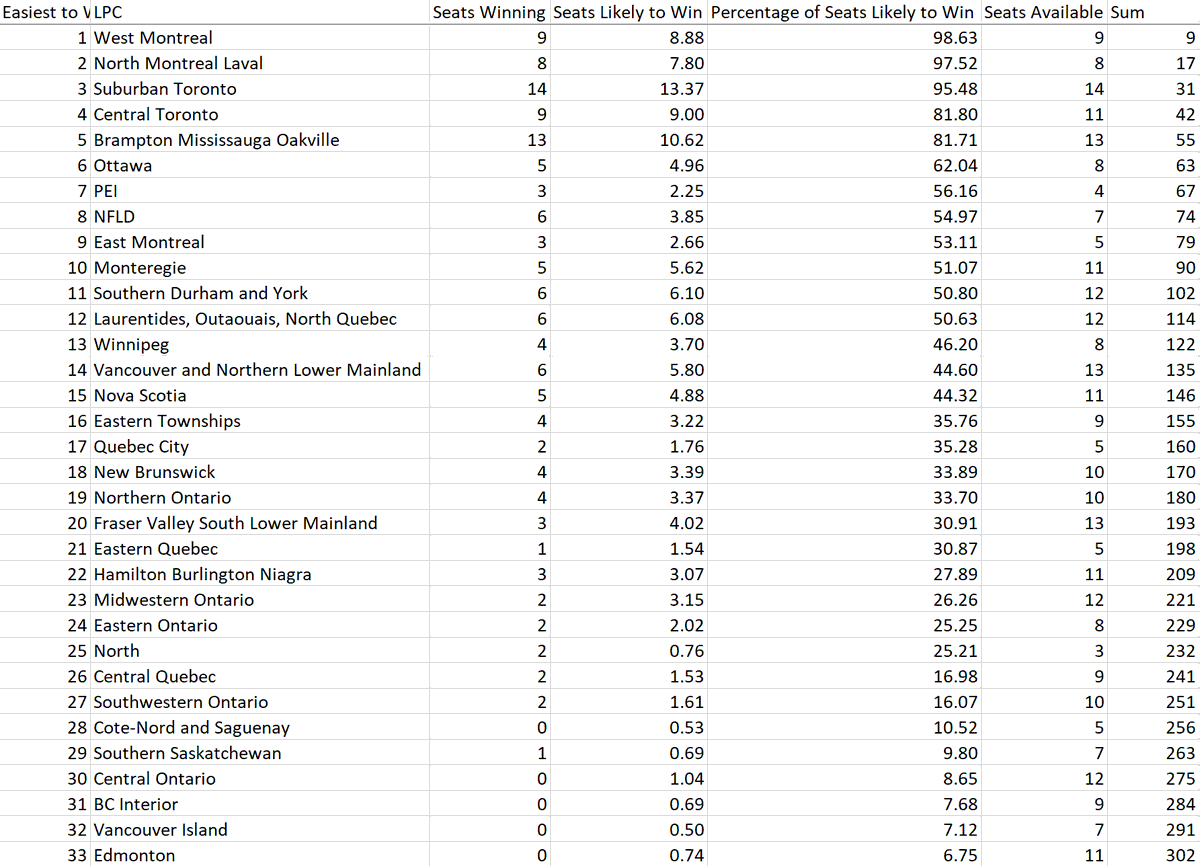
#cdnpoli #elxn44 Some wonder why I'm bearish on the chances of a CPC government and more bullish than others on the possibility of an LPC majority. I hope you'll enjoy this pre-English debate thread involving some math and pathways to victory for the big parties 🤓
Thread:
Thread:
1. Canada is a big country, and folks aren't familiar with all its regions. We know for example that within AB, Edmonton and Calgary are quite different than rural parts of the province. The same applies to other provinces and their respective regions.
2. For simplicity's sake, let's consider the thirty-seven regions broken down in the attached map. Wikipedia includes a list of ridings belonging to each region: en.wikipedia.org/wiki/Candidate… 

3. Breaking down the country into regions like this assumes that the ridings in those regions generally behave like others in those regions. This is not a flawless assumption, there are exceptions, but generally, these regions do share certain demographic similarities.
4. Using current polling, most poll aggregators estimate that the election is about even in terms of seats between the LPC and CPC. My own math suggests this, but I see some evidence that the CPC is slightly ahead going into tonight's debate.
5. So, I was wondering, what pathways are available to the two big parties to get a majority? My findings suggest that the pathway available to the CPC is a lot trickier considering historical results, but it certainly exists, and this is what it could potentially look like: 

6. So, what I've done is grouped the ridings per the attached wiki page, projected the current polling numbers using uniform swing, and calculated probability by running 10k simulated elections.
The way to read the chart is as follows:
Column 1 ranks the regions...
The way to read the chart is as follows:
Column 1 ranks the regions...
7. Column 2 is the name of the region from the wiki page above
Column 3 is the number of seats projected to win
Column 4 is the average number of seats won in that region in 10k simulated elections
Column 5 is the percentage of seats likely to be won in that region...
Column 3 is the number of seats projected to win
Column 4 is the average number of seats won in that region in 10k simulated elections
Column 5 is the percentage of seats likely to be won in that region...
8. Column 6 is the number of seats available in each region
Column 7 is the sum of the preceding seats available in the aforementioned regions.
Column 7 is the sum of the preceding seats available in the aforementioned regions.
9. So we can see some obvious things here at first, the CPC should be expected to win most of the seats in rural Alberta and Calgary, they do well in Saskatchewan, and the rural parts of Manitoba and Ontario. No surprises there.
10. Where things are interesting is that the CPC can avoid a good chunk of the GTA in order to get to its majority. In 2011, Harper was able to win primarily by breaking into the Peel region, and suburban Toronto. The map this time around has changed.
11. Instead, the CPC is more competitive in the Atlantic provinces and the Eastern parts of Quebec. These parts of the country are whiter, more working-class populations that tend to have less than a university-level education.
12. The CPC strategy, therefore, is designed to appeal to a cross-section of voters that allows the CPC to expand its seat count without relying heavily on the more immigrant-heavy, better-educated ridings in the GTA.
13. However, this is a difficult map, and it goes through much of Atlantic Canada and Eastern Quebec. The CPC has struggled quite badly in Atlantic Canada in recent history, and it remains to be seen if the negative brand the party has in those regions can stick.
14. Folks trying to recreate the 2011 victory will be surprised to see that places like Brampton Mississauga Oakville, and Suburban Toronto are comparatively more difficult regions to win this time around than Newfoundland. LPC candidates in NL beat the CPC by 54% in 2015!
15. However, places like Milton which survived in 2015, but was subsequently lost in 2019 are perhaps further out of reach than people expect. Something worth noting is the Legault endorsement. If it makes a difference, it will be in Central Quebec...
16. There are some BQ dominated areas in that part of the province that have the potential to flip. If the Legault endorsement made a difference, look to potential gains in Eastern and Central Quebec.
17. In any event, the lack of confidence on my part comes from historical data: these are parts of the country Conservatives have not won since the Mulroney days, hence my pessimism.
18. A calculation was made that the CPC could not replicate Harper 2011, and accordingly realigned themselves to appeal to a different cross-section of voters. I eagerly await election day to see if this gambit pays off.
19. So how about the Liberals? Based on historical results, it seems to me that the Liberals have several potential pathways to get to a majority that don't really represent as much of an uphill battle as the CPC: 

20. The Liberal path to a majority would need them to improve in the North and Western parts of Quebec, Southern Ontario, and British Columbia. These are areas that the Liberals have won more recently, so the map is potentially easier for them.
21. It's worth pointing out that the Liberals have a lower floor. Look at for example where the 60% and 30% marks are for each party:
For the CPC it's about 95 to 198, whereas for the Liberals it's about 63 to 198.
For the CPC it's about 95 to 198, whereas for the Liberals it's about 63 to 198.
22. Now those numbers don't necessarily represent a realistic seat range, but I think it's worth pointing out. Tossup regions can be considered those between 60% and 30%. The Liberals have 15 potential regions with 135 available seats to get the extra seats they need.
23. Conservatives on the other hand have 12 with 103 seats available. IMO, their potential pathway is narrower barring anything dramatic happening tonight, and really tonight is the last day for anything dramatic to happen.
24. It will be very interesting to see if these trends hold. If they do, we could end up with a very strange-looking map on September 21! Fin.
• • •
Missing some Tweet in this thread? You can try to
force a refresh



